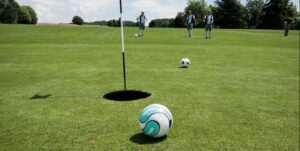Speed is an undeniable asset when it comes to nearly every sport. Being able to get from one point to another faster than your opponent can serve as a huge advantage in competition. However, an athlete’s ability to decelerate almost instantaneously can be a deciding factor in making game-changing plays. We’ve all witnessed an offensive basketball player dribble one direction full speed and then crossover to gain separation, or stop on a dime leaving the defensive player lost. Or perhaps you’ve seen a tennis player move laterally one direction and stop to serve a punishing swing the other way, scoring a point. Examples of deceleration are endless, and training to reduce maximum speed can give athletes the extra edge needed to excel at their given sport.
Drills
There are several drills that trainers can utilize to help athletes harness this skill, but there are some that are specific to their respective sports.
1) The L-drill: The L-drill is standard for football players looking to work on slowing down to prevent over pursuit and to increase explosion.
2) Super cuts: You will need a total of six cones. Three cones are lined up five yards apart in a straight line and then another three cones are staggered across from them (about seven to ten yards apart) creating a slanting, zig zag pattern. Athletes start at one cone, exploding full speed to the next but then decelerate before they reach that next cone. The athlete must keep his or her feet moving and then change direction, exploding again to the next cone. It’s like driving a car and slamming your foot all the way on the gas and then abruptly slamming all the way on the brakes. Continue this process until you reach the final cone.
Primary Components to Deceleration
1) Drop those hips, widen that base: The two primary components to deceleration are dropping (sinking) your hips and widening your base. When you run at max speed, your legs are extending, so to counter this action you have to “shrink” by lowering your center of gravity so that your legs cannot extend (sinking your hips). When sinking your hips, remember to always widen your base in order to maintain control of your body. Failure to do so could result in you losing balance and tipping over. Try incorporating deceleration drills in your training regiment; developing this skill will ultimately increase your athlete’s play making abilities.
CoachUp is the safest and easiest way to find a coach for personalized training. With our 100% money-back guarantee and vetted coaches, anyone can achieve their full athletic potential. Find your perfect coach today and become the athlete you want to be!
How useful was this post?
Click on a star to rate it!
Average rating 0 / 5. Vote count: 0
No votes so far! Be the first to rate this post.



